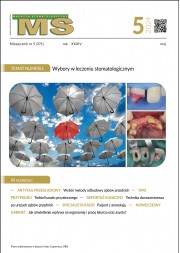Dostęp do tego artykułu jest płatny.
Zapraszamy do zakupu!
Cena: 6.15 PLN (z VAT)
Kup artykuł
Po dokonaniu zakupu artykuł w postaci pliku PDF prześlemy bezpośrednio pod twój adres e-mail.
How to extend the life of composite fillings?
Michał Ganowicz
Michał Ganowicz
Streszczenie
Wypełnienia w zębach bocznych to najczęściej wykonywane uzupełnienia w jamie ustnej. Praktycznie każdy lekarz dentysta wie, jak wykonać je prawidłowo, jednak trwałość wypełnień kompozytowych w zębach jest wciąż bardzo różna – wynosi od kilkunastu miesięcy do kilkunastu lat. Konieczność wymiany wypełnień w zębach bocznych zależy od bardzo wielu czynników. Istotne są właściwa ocena zęba, poziom higieny pacjenta, sposób opracowania ubytku, przygotowanie przyzębia, wybór materiału, sposób pracy z materiałem, stopień wypolerowania itp. Bardzo dużo zależy od tego, czy lekarz zadba odpowiednio o zęby pacjenta przed leczeniem, w trakcie leczenia i po leczeniu. Dobra higiena pacjenta, gładkie powierzchnie i systematyczne kontrole zwiększą żywotność wypełnień kompozytowych w jamie ustnej.
Abstract
Fillings in posterior teeth are the most common restorations carried out in the oral cavity. Practically every dentist knows how to correctly carry them out. However, the durability of composite fillings in teeth still varies a lot – it ranges from a few months to a few years. The necessity of replacing fillings in posterior teeth depends on a great number of factors. It is fundamental to have a correct evaluation of the tooth, a correct level of patient oral hygiene, a method of cavity preparation, preparation of periodontium, choice of material, the way of working with the material, level of polish etc. It depends a lot on whether the dentist cares appropriately for the patient’s dentition before treatment, during the course of treatment and after treatment. Good patient oral hygiene, smooth surfaces and and systematic control visits increase the longevity of composite fillings in the oral cavity.
Hasła indeksowe: wypełnienie kompozytowe, trwałość wypełnień, ubytki w zębach bocznych
Key words: composite fillings, durability of fillings, cavities in posterior teeth
PIŚMIENNICTWO
1. Demarco F.F. i wsp.: Longevity of posterior composite restorations: not only a matter of materials. Dent. Mater., 2012, 1, 28, 1, 87-101.
2. Litonjua L.A., Cabanilla L.L., Abbott L.J.: Plaque formation and marginal gingivitis associated with restorative materials. Compend. Contin. Educ. Dent., 2012, 1, 33, 1, e6-10. Review.
3. Gharechahi M., Moosavi H., Forghani M.: Effect of surface roughness and materials composition. J. Biomater. Nanobiotech., 2012, 3,4A, 541-546.
4. Lutz F., Imfeld T., Schüpbach P.: Prophylaxis pastes – the new abrasive Perlit compared to conventional polishing substances. Schweiz. Monatsschr. Zahnmed., 1995, 105, 1, 30-39.
5. Bourbia M. i wsp.: Cariogenic bacteria degrade dental resin composites and adhesives. J. Dent. Res., 2013, 11, 92, 11, 989-994.













